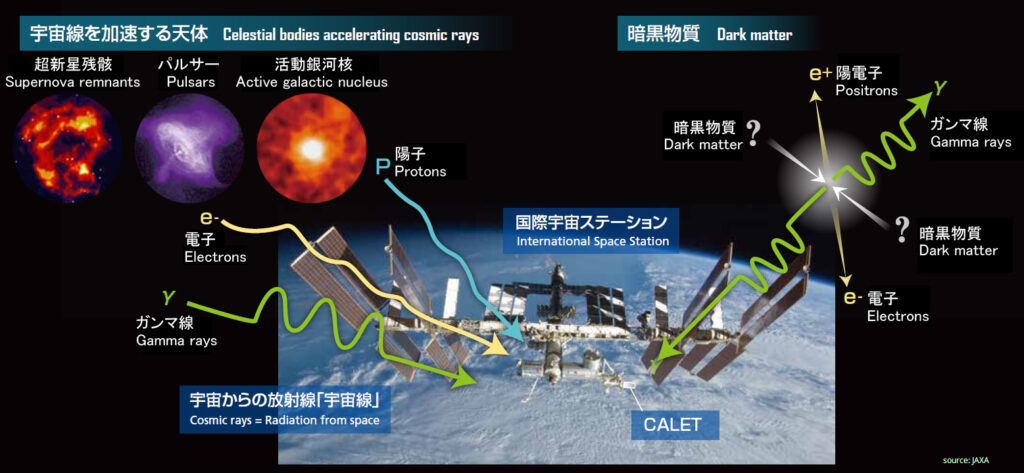General Introduction
•What are cosmic rays?
◦ Particles (nuclei, elementary particles) with high kinetic energy in space
•Where do they come from?
◦ They are accelerated by astrophysical objects with strong magnetic fields such as supernova remnants (SNR) and pulsars.
◦ Maybe some are created by the annihilation/decay of dark matter.
•Why should we care to study them?
◦ We can use them to study these astrophysical objects and search for dark matter, but also gain new insights into particle physics since cosmic rays reach higher energy than any accelerator on Earth
•How are they studied?
◦ Detectors either perform a direct measurement of the cosmic ray particles in space or in the higher atmosphere, or they observe them indirectly through their reaction with Earth’s atmosphere.
Free online course on edX: WasedaX: Cosmic Rays, Dark Matter, and the Mysteries of the Universe
CALET
The CALorimetric Electron Telescope (CALET) detector is in operation on the International Space Station (ISS) since 2015. It is optimized to measures the energy spectrum of electron and positron cosmic rays up to the TeV energy range with high energy resolution, but also takes measurements of the cosmic ray nuclei spectra and gamma rays.

CALET is operated by an international collaboration comprised of the space agencies of Japan (JAXA), USA (NASA) and Italy (ASI), as well as 22
universities from these three countries. Waseda is the lead scientific institution. There are approximately 80 collaboration members + students.
CALET websites: https://calet.jp/ (Japanese) ; https://calet.phys.lsu.edu/ (English – USA) ; https://galileo.dsfta.unisi.it/ (English – Italy)
Specific Research Topics
Cosmic Ray Propagation
Being charged particles, cosmic rays are deflected by the galactic magnetic field on their journey from their sources to Earth. Thus a cosmic-ray particle’s arrival direction in the detector does not point back towards its source. The propagation of galactic cosmic rays is rather a diffusion process, depending on various parameters describing the galactic environment. The interaction of the cosmic rays with the magnetic field and interstellar matter changes their energy spectrum and also causes the production of secondary cosmic rays. We conduct simulations of these propagation processes depending on the unknown parameters and compare their results to measured cosmic-ray nuclei spectra from CALET and other experiments to construct a self-consistent model of cosmic ray sources and propagation.
Publication for reference (Proceedings of ICRC2023): A Cosmic-Ray Propagation Model based on Measured Nuclei Spectra
Search for Signatures of Nearby SNR in Electron Cosmic Rays
Unlike the nuclei cosmic rays which have a range similar to the size of the Galaxy, high-energy electron cosmic rays will lose most their energy over a
distance of a few kilo-parsec. Therefore, only a handful of SNR sources is expected to contribute to the electron cosmic-ray spectrum in the TeV energy range, which is being measured for the first time with high precision by CALET. While the average spectrum of many contributing sources at lower energy forms a smooth power law, the few sources at TeV energy could create distinctive spectral structures, which could be identified as their individual signatures and reveal their properties.
Publication for reference (Proceedings of ICRC2021): Investigating the Vela SNR’s Emission of Electron Cosmic Rays with CALET at the International Space Station
Dark Matter Search
Our research consists of calculating the expected flux from dark matter annihilation or decay for different dark matter candidate particles, taking cosmic-ray propagation into account. Using these flux predictions, we derive constraints on the properties of the dark matter particle, such as its self-annihilation cross section as a function of mass, by quantitative comparison with the electron spectrum of CALET and data from other experiments.
Publications for reference:
Proceedings of ICRC2023: Dark Matter Limits from the CALET Electron+Positron Spectrum with Individual Astrophysical Source Background
Phys. Rev. D: Cosmic-ray signatures of dark matter from a flavor dependent gauge symmetry model with neutrino mass mechanism
JCAP: CALET’s sensitivity to Dark Matter annihilation in the galactic halo